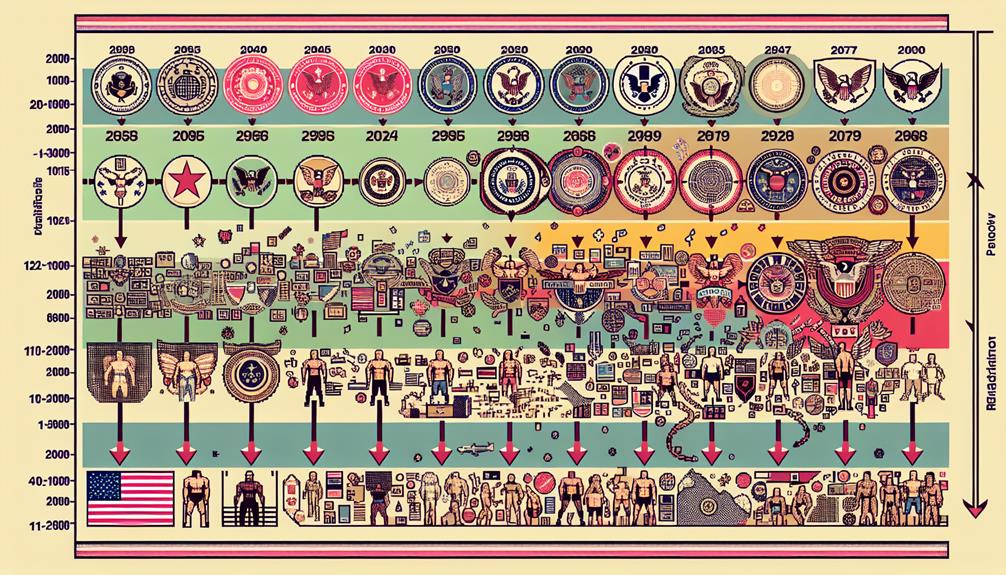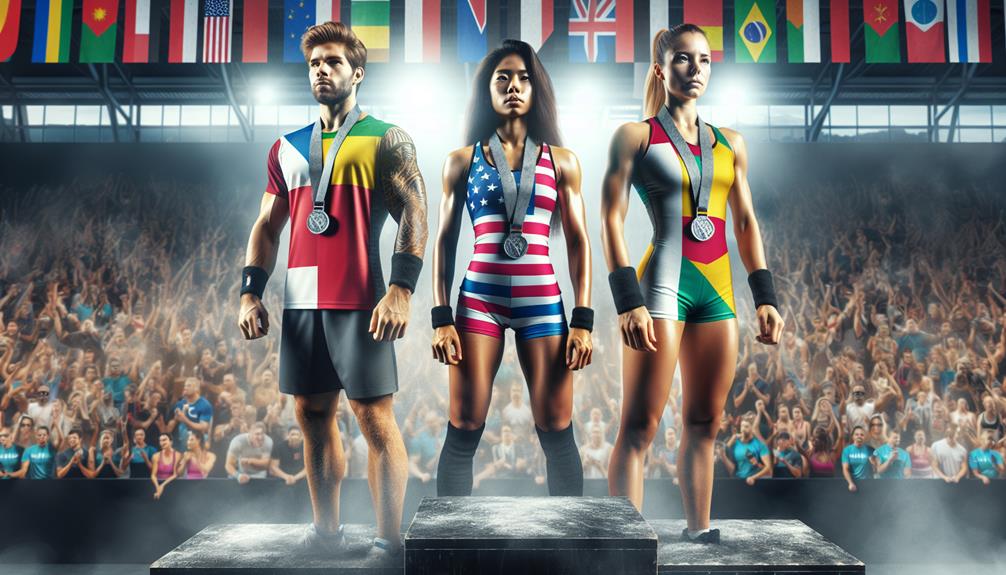In the early days of CrossFit Games, the competition was akin to a rugged frontier town, with athletes testing their mettle in unconventional ways. But as time marched on, the landscape of the Games shifted dramatically, mirroring the evolution of the sport itself. From humble beginnings to a global phenomenon, the CrossFit Games have undergone significant changes that have shaped the way competitors train, compete, and ultimately define what it means to be the fittest on Earth.
Key Takeaways
- Founding athletes like Thorisdottir and Froning shaped early Games.
- Regional Qualifiers enhanced competition standards and regional representation.
- Age Group Divisions promote inclusivity and recognize Masters athletes.
- National Champions highlight individual country representation, fostering national pride in the Games.
Origins and Early Years
The inception of the CrossFit Games can be traced back to the early 2000s when fitness enthusiast Greg Glassman developed a unique and intense training program that would eventually evolve into a global sporting phenomenon. In the early beginnings, CrossFit was gaining traction as a fitness regimen that focused on functional movements performed at high intensity. As the program grew in popularity, Glassman, along with founding athletes like Annie Thorisdottir and Rich Froning, saw the potential to create a competitive outlet to test the effectiveness of their training methods.
During the early years of the CrossFit Games, the competition was relatively small, with participants primarily consisting of dedicated CrossFit followers. Athletes would gather to showcase their skills in events that combined elements of weightlifting, gymnastics, and cardiovascular endurance. These early competitions laid the foundation for what would later become a highly anticipated annual event that attracts elite athletes from around the world. The dedication and passion of these founding athletes played a crucial role in shaping the competitive nature of the CrossFit Games.
Expansion and Global Reach
With the growing popularity of CrossFit, its expansion and global reach have been propelled by a network of dedicated affiliates and athletes committed to spreading the program's impact worldwide. CrossFit's global impact is evident in its presence in over 150 countries, showcasing the program's ability to transcend borders and cultures. The cultural diversity within the CrossFit community enriches the competition, bringing together athletes from various backgrounds and traditions to celebrate fitness and camaraderie.
As CrossFit expanded internationally, it adapted to different regions' needs and preferences, further solidifying its global influence. The establishment of CrossFit affiliates across the world not only facilitated the sport's growth but also fostered a sense of unity among athletes worldwide. The CrossFit Games, once a relatively small event, now attracts participants from diverse countries, showcasing the program's ability to connect individuals from different parts of the globe through a shared passion for fitness.
CrossFit's expansion and global reach have not only transformed the competition but have also created a platform for cultural exchange and mutual respect among athletes, highlighting the universal appeal of the sport.
Shift to Regional Qualifiers

Expanding its competitive structure, CrossFit Games made a significant shift to Regional Qualifiers, altering the landscape of the competition and refining the selection process for elite athletes. This change aimed to enhance regional diversity and ensure consistent competitive standards across all regions. Regional Qualifiers provided athletes with the opportunity to compete closer to home before advancing to the Games, fostering a sense of community and support within local CrossFit boxes.
The implementation of Regional Qualifiers also raised the level of competition, as athletes had to prove themselves against a larger pool of competitors in their region before earning a spot at the Games. This shift not only emphasized the importance of regional representation but also set a higher bar for athletes to showcase their skills and fitness capabilities. By focusing on regional qualifiers, CrossFit Games established a more structured and rigorous path for athletes to demonstrate their readiness for the ultimate test at the Games.
Introduction of Age Group Divisions
Introducing Age Group Divisions marked a pivotal evolution in the competitive landscape of the CrossFit Games, catering to a broader spectrum of athletes and enhancing inclusivity within the community. This innovation not only acknowledged the growing number of Masters athletes but also fostered competitive diversity across various age categories. The introduction of Age Group Divisions reshaped the CrossFit Games in significant ways:
- Inclusivity: Allowing athletes of different ages to compete on a level playing field.
- Recognition: Providing Masters athletes with a platform to showcase their skills and dedication.
- Diversification: Encouraging a wider range of participants to engage in the competitive aspect of CrossFit.
- Inspiration: Serving as motivation for individuals of all ages to pursue their fitness goals.
- Community Bonding: Creating a more cohesive community by uniting athletes with shared passions and goals.
The Emergence of National Champions

National Champions have been steadily emerging in the competitive landscape of the CrossFit Games, marking a notable shift in focus towards individual country representation and talent recognition. This trend began gaining traction in recent years as CrossFit aimed to foster national pride and offer athletes a unique competitive edge. The introduction of National Champions has added a layer of excitement to the Games, with athletes not only competing for personal glory but also representing their respective countries on a global platform.
The emergence of National Champions has brought about a renewed sense of national pride among athletes and fans alike. It has created a dynamic where athletes strive not only to be the best in the world but also to be the best representative of their nation. This shift has injected a new level of intensity into the competition, with athletes pushing themselves to excel not just for personal achievement but also for the honor of their country. The recognition of National Champions has added a compelling dimension to the CrossFit Games, emphasizing the diversity and talent present in the global CrossFit community.
Frequently Asked Questions
What Are Some Common Misconceptions About the Crossfit Games Competition?
You might think steroid use is rampant at the CrossFit Games, but in reality, athletes are rigorously tested for performance-enhancing drugs. Misconceptions about extreme training techniques and nutrition myths prevail, overshadowing the athletes' dedication and hard work.
How Has Social Media Impacted the Way Athletes Train and Prepare for the Crossfit Games?
Social media has revolutionized how athletes train for the CrossFit Games. By sharing workouts, techniques, and strategies online, athletes gain insights, motivation, and community support. This virtual training hub enhances performance, fosters connections, and pushes boundaries.
Are There Any Controversial Moments or Scandals That Have Occurred During the History of the Crossfit Games?
When it comes to the CrossFit Games, controversial moments and scandals have definitely left their mark over the years. From questionable judging calls to athlete disqualifications, the competition has seen its fair share of drama.
How Do Sponsors and Partnerships Play a Role in the Success and Growth of the Crossfit Games?
Sponsors and partnerships fuel the success of the CrossFit Games. Sponsorship impact is evident in increased prize money and production quality, while partnership growth expands reach and resources. These collaborations are crucial for sustaining and growing the competition.
What Are Some of the Unique Challenges Faced by Female Athletes in the Crossfit Games Compared to Their Male Counterparts?
As a female athlete at the CrossFit Games, you may encounter unique challenges like battling stereotypes, breaking barriers, and striving for gender equality. Your journey is not just about competition but also about female empowerment.
Conclusion
You have now journeyed through the evolution of the CrossFit Games, witnessing its humble beginnings, global expansion, and innovative changes. But the story doesn't end here. As the competition continues to evolve, new champions will rise, new records will be broken, and new challenges will test the limits of human performance. Stay tuned for the next chapter in the ever-evolving history of the CrossFit Games.













